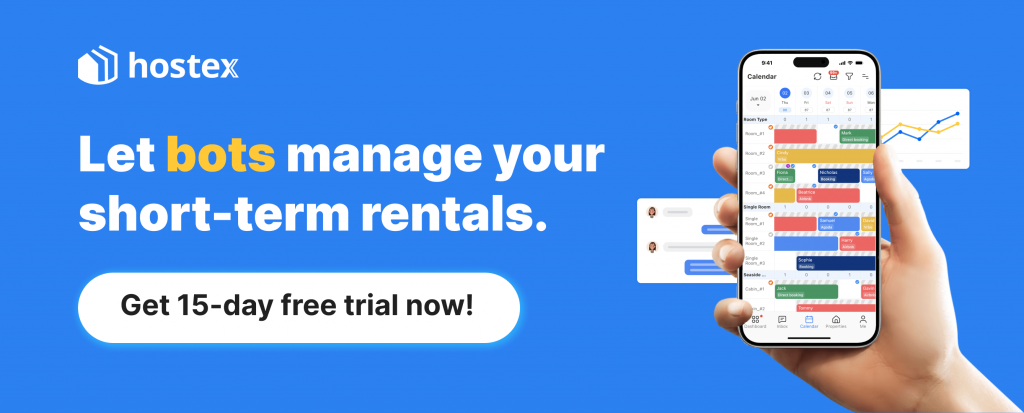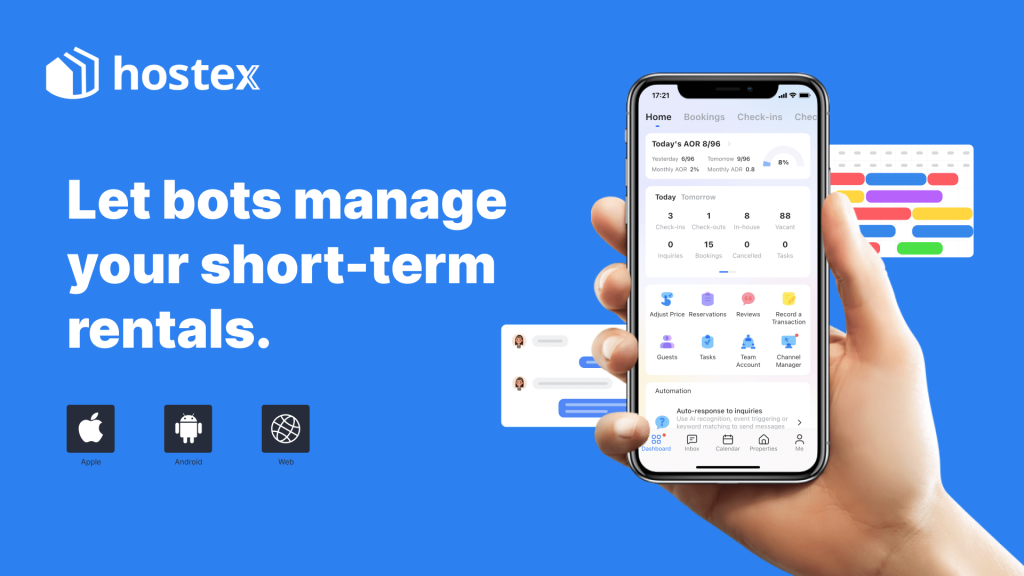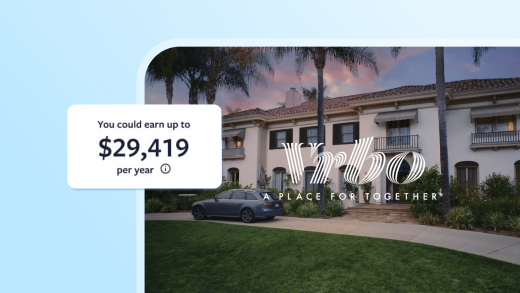Cada vez mais pessoas estão recorrendo a aluguéis de temporada como forma de obter uma renda extra ou até mesmo construir um negócio em tempo integral. Na verdade, é um caminho comprovado e eficaz para o sucesso financeiro. No entanto, a gestão de aluguéis de curta temporada envolve muito mais do que apenas listar um imóvel e aguardando reservas. De comunicação com o hóspede para preços, cronogramas de limpeza para revisões — cada etapa exige tempo, esforço e atenção aos detalhes.
Neste guia, apresentaremos os fundamentos da gestão de aluguéis de curta temporada. Seja administrando um ou vários imóveis, as dicas abaixo ajudarão você a evitar armadilhas comuns e a administrar seu aluguel como um profissional.
Se você quer economizar tempo, Hostex pode automatizar mais de 70% de tarefas diárias e ajudá-lo gerencie todas as suas listagens em todas as plataformas, a partir de apenas $4.9/mês.

O que é Gestão de Aluguéis de Curto Prazo?
A gestão de aluguéis de curta duração (gestão de STR) refere-se ao processo de operar imóveis para aluguel de curta duração, como casas de férias ou apartamentos, com o objetivo de gerar renda. Normalmente, essa tarefa é realizada pelos proprietários dos imóveis, administradores de propriedades, ou empresas de gestão profissional.
Comparado aos aluguéis de longo prazo, a gestão de um imóvel STR envolve muito mais trabalho prático. No entanto, sua flexibilidade também o torna uma ótima opção para freelancers, trabalhadores remotos ou qualquer pessoa que busque renda adicional.
As principais responsabilidades da gestão de aluguéis de curto prazo incluem:
- Gerenciando listagens OTA
- Coordenação de calendários e reservas
- Definir e ajustar preços
- Agendamento de limpeza e manutenção
- Gerenciando check-ins e check-outs
- Comunicando-se com os hóspedes
- Criando excelentes experiências para os hóspedes
- Gerenciando avaliações de hóspedes
- Comercialização da propriedade
Você pode lidar com essas tarefas manualmente. No entanto, usando software de gerenciamento de aluguel de férias pode otimizar suas operações e economizar tempo valioso.
Em última análise, o objetivo da gestão de alugueres de curta duração é garantir operações tranquilas e proporcionar um excelente experiência do hóspede, e permanecer competitivo para maximizar os lucros.

Qual é a diferença entre Longo prazo e Curto Prazo Gestão de Aluguel?
Se você está decidindo entre a gestão de aluguéis de curto e longo prazo, é importante entender as diferenças entre os dois. Embora ambos possam ser lucrativos, cada modelo exige diferentes níveis de envolvimento, habilidades e recursos. Portanto, aqui estão as principais diferenças para ajudar você a escolher o mais adequado para o seu imóvel e seus objetivos:
1. Tipo de propriedade
Aluguéis de curta temporada geralmente envolvem casas de férias, apartamentos mobiliados ou condomínios urbanos localizados em áreas turísticas. Como resultado, esses imóveis costumam ser projetados para atrair viajantes que buscam conforto e conveniência.
Aluguéis de longo prazo, por outro lado, geralmente envolvem moradias mais tradicionais — apartamentos sem mobília ou casas unifamiliares adequadas para inquilinos que ficam por vários meses ou anos.
2. Duração do aluguel
Aluguéis de curta temporada geralmente são reservados por alguns dias ou algumas semanas. Consequentemente, essa rotatividade frequente de hóspedes permite preços flexíveis, mas também exige uma gestão mais prática.
Por outro lado, os aluguéis de longo prazo têm contratos de locação fixos, geralmente com duração de seis meses a um ano ou mais, que oferecem uma renda mais estável e exigem menos envolvimento no dia a dia.
3. Responsabilidades do dia a dia
A gestão de aluguéis de curta temporada exige atenção constante. Por exemplo, você precisa atualizar os anúncios regularmente, gerenciar as reservas, coordenar a limpeza entre as estadias, gerenciar a comunicação com os hóspedes e responder às avaliações.
Em contrapartida, aluguéis de longa duração envolvem interações menos frequentes. A maioria das tarefas se concentra em contratos de locação, cobrança de aluguel, solicitações de manutenção e triagem de inquilinos.
4. Requisitos de Habilidade
Gerenciar um aluguel de curta temporada muitas vezes se assemelha à gestão de um negócio de hospitalidade. Portanto, exige habilidades em atendimento ao cliente, precificação dinâmica, marketing e operações.
A gestão de aluguéis de longo prazo tem mais a ver com conhecimento imobiliário e conformidade legal, como leis de locação e procedimentos de despejo.
5. Tipo de hóspede vs. inquilino
Os hóspedes de aluguéis de curta temporada são viajantes — turistas, viajantes a negócios ou nômades digitais. Eles buscam uma estadia confortável e uma ótima experiência.
Já os inquilinos de aluguel de longa duração geralmente são moradores locais ou pessoas que se mudam por motivos de trabalho ou familiares. Eles esperam estabilidade na moradia, privacidade e menos interação com o proprietário.
6. Potencial de renda
Aluguéis de curta temporada geralmente oferecem maior potencial de renda devido aos preços noturnos e aos picos sazonais de demanda. No entanto, isso acarreta custos operacionais mais altos e maior comprometimento de tempo.
Aluguéis de longo prazo proporcionam renda mensal consistente com menos volatilidade, mas geralmente margens de lucro gerais mais baixas.
Prós e contras da gestão de aluguéis de curto prazo
A gestão de aluguéis de curta temporada oferece oportunidades empolgantes, especialmente para proprietários que buscam mais controle e flexibilidade. No entanto, também traz desafios específicos que é importante considerar antes de se aventurar.
Prós
1. Maior retorno sobre o investimento
Aluguéis de curto prazo costumam gerar mais receita do que os tradicionais de longo prazo, especialmente em locais com alta demanda. Com o preço por noite, você pode ajustar as tarifas com base na sazonalidade, eventos ou tendências de demanda.
2. Estilo de vida flexível
Você é responsável pela sua própria agenda. Muitos anfitriões gerenciam seus aluguéis em meio período ou remotamente, tornando a gestão de aluguéis de curto prazo ideal para renda extra ou trabalho remoto.
3. Suporte e proteções da plataforma
As principais plataformas de OTA, como Airbnb e Booking.com, oferecem suporte integrado, cobertura de seguro e resolução de disputas. Essas ferramentas ajudam a reduzir riscos e melhorar sua experiência de hospedagem.
4. Fluxos de renda diversificados
Ao anunciar seu imóvel em diversas plataformas, você pode alcançar diferentes tipos de hóspedes e aumentar a ocupação. Serviços adicionais, como check-in antecipado ou taxas de limpeza, também podem aumentar sua renda.
Contras
1. Operações diárias mais detalhadas
Gerenciar aluguéis de curta temporada significa lidar com a rotatividade constante de hóspedes, mensagens, limpeza e manutenção. Exige tempo, organização e excelentes habilidades de atendimento.
2. Maiores custos de manutenção
Hospedagens frequentes causam mais desgaste. Você precisará orçar reparos regulares, reposição de estoque e limpeza profissional entre as reservas.
3. Regulamentações legais mais rigorosas
Muitas cidades agora aplicam leis de zoneamento, requisitos de licenciamento e regras tributárias para aluguéis de curta temporada. Manter a conformidade pode ser demorado e complexo.
4. Flutuações sazonais
A renda com aluguel de curto prazo pode variar significativamente de acordo com as estações do ano, eventos locais e tendências de viagens. Você pode ter altos rendimentos no verão, mas baixa ocupação na baixa temporada.

Introdução à gestão de aluguéis de curta duração
Se você planeja contratar um gestor de imóveis ou empresa de gestão de alugueres de curta duração, esta seção pode não se aplicar a você. Já publicamos um guia detalhado sobre esses tópicos.
No entanto, se você deseja controle total sobre seu imóvel para alugar, gerenciá-lo você mesmo é perfeitamente possível. A gestão de aluguéis de curta temporada não é tão complexa quanto parece, e você economizará em altas taxas de administração de imóveis.
Veja o que você precisa preparar antes de começar.
1. Defina metas comerciais claras
Todo negócio de aluguel bem-sucedido começa com uma visão clara. Pergunte a si mesmo o que você deseja alcançar — seja uma renda estável, experiências excepcionais para os hóspedes ou valorização do imóvel a longo prazo. Com metas claras, você pode criar um roteiro e acompanhar seu progresso com mais eficácia.
2. Entenda os regulamentos locais e obtenha a licença
Antes de receber hóspedes, certifique-se de que sua propriedade esteja em conformidade com as leis locais. Muitas cidades exigem licenças para aluguel de curta temporada, registro fiscal ou medidas de segurança específicas. As regulamentações variam muito de acordo com o local, portanto, reserve um tempo para pesquisar e obter as licenças necessárias.
3. Defina seu mercado-alvo
Saber quem você deseja hospedar é fundamental para criar um anúncio de sucesso. Considere a localização, o tamanho e as comodidades do seu imóvel — você atende viajantes a negócios, famílias ou turistas de fim de semana? Identificar o hóspede ideal ajuda a personalizar seu anúncio, seus preços e suas estratégias de marketing.
4. Crie um plano de marketing
Mesmo o melhor imóvel não conseguirá reservas sem visibilidade. Decida quais plataformas você usará (como Airbnb, Booking.com ou VRBO), defina uma estratégia de preços e planeje como promover seu anúncio. Um plano de marketing sólido pode fazer toda a diferença em um mercado de locação competitivo.
5. Prepare sua propriedade para receber hóspedes
Seu aluguel de temporada precisa ser mais do que apenas habitável — ele deve ser como um lar longe de casa. Equipe o espaço com itens essenciais, como roupas de cama limpas, utensílios de cozinha e produtos de higiene pessoal. Em seguida, considere adicionar extras como cafeteira, Wi-Fi de alta velocidade ou fechaduras inteligentes para aprimorar a experiência do hóspede e receber ótimas avaliações.

Gestão de Aluguel de Curto Prazo: O que os Anfitriões Fazem
Gerenciar um aluguel de curta temporada não se trata apenas de entregar as chaves — trata-se de administrar um negócio de hospitalidade. Abaixo, você encontra as principais responsabilidades que todo anfitrião precisa dominar, juntamente com etapas práticas para começar.
1. Criação e gerenciamento de listagens
Seu anúncio online é a primeira impressão para potenciais hóspedes. Reserve um tempo para:
- Anunciado nas principais plataformas de aluguel por temporada, como Airbnb, Booking.com e Vrbo. Cada plataforma tem seu próprio público.
- Escreva um título e uma descrição claros e envolventes que destaquem as características únicas da sua casa.
- Use fotos de alta qualidade e bem iluminadas, especialmente de quartos, banheiros e quaisquer comodidades especiais.
- Liste todas as comodidades honestamente e mantenha seus dados atualizados.
2. Gerenciando calendários e disponibilidade
Reservas duplicadas podem arruinar sua reputação. Mantenha seu calendário atualizado em todas as plataformas:
- Use um gerenciador de canais ou PMS (Sistema de Gerenciamento de Propriedades) para sincronizar seus calendários.
- Bloquear datas para manutenção ou uso pessoal com antecedência.
- Verificar regularmente se há sobreposições de reservas ou problemas de sincronização do sistema.
3. Definição de preços inteligentes
Preços muito altos podem deixar sua agenda vazia, enquanto preços muito baixos prejudicam os lucros. Considere:
- Sazonalidade: ajuste os preços durante a alta e baixa temporada.
- Eventos locais: Aumente os preços quando grandes eventos acontecerem nas proximidades.
- Análise da concorrência: use ferramentas para comparar seus preços com aluguéis semelhantes.
- Descontos de última hora e duração da estadia para aumentar a ocupação.
4. Manuseio de limpeza e manutenção
Um espaço impecável e bem cuidado é fundamental para avaliações positivas. Crie um sistema confiável:
- Crie uma lista de verificação de limpeza para dias de rotatividade (trocar roupas de cama, reabastecer suprimentos, higienizar superfícies).
- Agende limpezas profundas e verificações regulares dos eletrodomésticos.
- Use ferramentas de gerenciamento de tarefas ou recursos de PMS para atribuir tarefas de limpeza automaticamente.
5. Comunicação com os hóspedes
Uma boa comunicação gera confiança e leva a avaliações melhores. Veja como fazer isso:
- Responda às perguntas rapidamente, de preferência em até uma hora.
- Envie mensagens automatizadas programadas para confirmações de reservas, instruções de check-in e notas de agradecimento.
- Esteja disponível para responder perguntas durante a estadia ou use ferramentas de IA para ajudar.
6. Gerenciando check-in e check-out
Um check-in tranquilo define o tom da estadia. Prepare-se da seguinte forma:
- Oferecendo opções flexíveis de check-in, como fechaduras inteligentes ou cofres.
- Envio de instruções claras com fotos ou vídeos.
- Deixando um guia de boas-vindas impresso com informações sobre Wi-Fi, regras da casa e recomendações locais.
7. Manter registros e manter a conformidade
Finanças organizadas ajudam você a se manter lucrativo e preparado para pagar impostos. Certifique-se de:
- Acompanhe receitas, despesas, reparos e depósitos de hóspedes.
- Armazene recibos e exporte relatórios mensais do seu PMS.
- Entenda as obrigações fiscais locais e registre-se junto às autoridades locais, se necessário.
8. Comercializando sua propriedade
Não dependa apenas de plataformas de reserva — promova ativamente seu aluguel para aumentar a visibilidade:
- Crie um site de reserva direta (muitas plataformas de PMS, como a Hostex, oferecem isso).
- Crie uma presença nas redes sociais para atrair hóspedes recorrentes.
- Colete e-mails de hóspedes e envie boletins informativos ou promoções ocasionais.
- Incentive avaliações e indicações para construir credibilidade.

Dicas essenciais para uma gestão eficaz de alugueres de curta duração
Gerenciar um imóvel para aluguel de curta temporada exige mais do que apenas anunciá-lo online. Para ter sucesso, você precisa se manter organizado, eficiente e ágil, garantindo operações tranquilas e hóspedes felizes. Aqui estão cinco dicas essenciais que todo novo anfitrião deve seguir.
1. Mantenha seu calendário e reservas sincronizados
Evitar reservas duplicadas é fundamental na gestão de aluguéis de curta temporada. Mantenha seu calendário sempre atualizado em todas as plataformas.
Gerente de Canal As ferramentas podem sincronizar automaticamente reservas de vários canais, ajudando você a evitar conflitos de agendamento e economizar horas de trabalho manual.
2. Comunique-se prontamente com os hóspedes
Uma comunicação rápida e amigável gera confiança e resulta em avaliações melhores. Responda rapidamente às perguntas dos hóspedes, confirmações de reservas e perguntas sobre o check-in.
Você pode automatizar todas as mensagens usando software de aluguel de férias, garantindo que seus convidados sempre se sintam bem atendidos, sem desperdiçar seu tempo.
3. Acompanhe receitas e despesas com precisão
Uma gestão bem-sucedida de aluguéis de curta temporada exige um orçamento inteligente. Mantenha registros detalhados de cada pagamento, taxa de limpeza ou custo de reparo.
Usar ferramentas analíticas para centralizar o controle de suas receitas e despesas, tornando a declaração de impostos e a análise de desempenho muito mais fáceis.
4. Coletar e gerenciar avaliações de hóspedes
Avaliações positivas são a sua ferramenta de marketing mais poderosa. Ofereça uma ótima experiência do check-in ao check-out e, em seguida, faça um acompanhamento com uma solicitação educada de avaliação.
Maioria software de aluguel de férias permite que você automatize esse processo e monitore seu desempenho de avaliação em todas as plataformas.
5. Mantenha-se atualizado sobre limpeza e manutenção
A limpeza é um dos principais motivos pelos quais os hóspedes deixam avaliações boas ou ruins. Estabeleça uma rotina de limpeza consistente e não ignore pequenos problemas de manutenção.
Com ferramentas como a Hostex, você pode atribuir e rastrear tarefas de limpeza automaticamente, garantindo que nada passe despercebido entre as reservas.
6. Crie seu site de reservas diretas
Possuir um site de reserva direta ajuda você a cortar taxas de OTA e aumentar seus lucros.
Com a Hostex, você pode criar seu próprio site de reservas profissional sem código e sem taxas. Você pode até publicar seus anúncios diretamente no Aluguel de férias do Google com um clique, expandindo seu alcance sem esforço.

Escolhendo o software certo de gerenciamento de aluguel de curto prazo
O software de gestão de aluguéis de curta temporada ideal pode simplificar seu fluxo de trabalho, reduzir tarefas manuais e aumentar seus ganhos. Aqui estão os principais fatores a serem considerados ao selecionar a melhor ferramenta para o seu negócio:
1. Principais recursos e automação
Comece avaliando os principais recursos do software. Ele deve abranger tarefas essenciais como sincronização de calendário, mensagens automatizadas, gerenciamento de reservas, gerenciamento de avaliações, coordenação de limpeza e criação direta de sites de reservas.
2. Facilidade de uso
Uma interface intuitiva e bem projetada facilita o gerenciamento das suas operações sem uma curva de aprendizado acentuada. Pontos extras se o software oferecer um aplicativo móvel, que lhe dá controle total do seu negócio de aluguel, mesmo quando você estiver em trânsito.
3. Integrações com outras ferramentas
Escolha uma plataforma que funcione bem com as outras ferramentas que você já usa. A integração perfeita com ferramentas de precificação dinâmica, fechaduras inteligentes, processadores de pagamento e plataformas OTA pode economizar tempo e evitar erros dispendiosos.
4. Suporte ao cliente confiável
As coisas podem dar errado, mesmo com o melhor software. É por isso que um suporte ao cliente ágil e prestativo é essencial. Escolha um provedor que ofereça suporte por chat ao vivo ou e-mail, além de uma base de conhecimento para ajudar você a começar e solucionar problemas rapidamente quando necessário.
5. Preços transparentes e valor real
O custo importa. Procure softwares que ofereçam ótimo custo-benefício sem taxas ocultas. As melhores ferramentas cobram uma taxa mensal fixa que inclui todos os recursos essenciais, para que você saiba exatamente o que está pagando.

Hostex: Seu Assistente Inteligente para Gestão de Aluguéis de Curta Duração
Hostex é uma plataforma de gerenciamento de aluguel de curto prazo completa e econômica que ajuda você a automatizar mais de 70% de tarefas de rotina, permitindo que você economize tempo, reduza o estresse e se concentre no crescimento do seu negócio.
E a melhor parte? Tudo começa com apenas $4,90 por mês.
O que a Hostex pode fazer por você:
- Gerente de Canal: Sincronize anúncios no Airbnb, Booking.com, Vrbo, Agoda e muito mais via API direta e iCal. Evite reservas duplicadas e gerencie tudo em um único painel.
- Automação Poderosa: Automatize mensagens para hóspedes, instruções de check-in, atualizações de preços, avaliações e tarefas de limpeza — tudo isso sem precisar levantar um dedo.
- Site de reserva direta: Crie seu próprio site sem codificação ou custo extra e publique-o diretamente no Google Vacation Rentals para aumentar as reservas sem comissão.
- Integrações de terceiros: Conecte-se perfeitamente com ferramentas como PriceLabs, Rategenie, Turno, fechaduras inteligentes e outros itens essenciais da STR.
- Colaboração em equipe: Atribua funções aos membros da equipe — proprietários, faxineiros, contadores e muito mais — com permissões de acesso personalizáveis.
- Controle Móvel: Gerencie seu negócio a qualquer hora e em qualquer lugar com o aplicativo móvel Hostex.
- Preços claros: A Hostex oferece preços transparentes e com tudo incluído com sem taxas ocultasQuanto mais anúncios você gerenciar, menor será a taxa por propriedade.
Não importa se você gerencia um único anúncio ou expande uma operação com várias propriedades, a Hostex oferece tudo o que você precisa para simplificar e agilizar o gerenciamento de aluguéis de curto prazo, sem gastar muito.

Considerações finais
A gestão de aluguéis de curta temporada pode parecer desafiadora no início, especialmente para iniciantes. Mas, com o conhecimento, as ferramentas e a mentalidade certos, pode se tornar um empreendimento gratificante e lucrativo. Seja para administrar um único imóvel ou expandir para vários anúncios, manter-se organizado e proporcionar ótimas experiências aos hóspedes é fundamental.
Esperamos que este guia tenha lhe dado um ponto de partida claro e a confiança necessária para assumir o controle do seu negócio de aluguel. E lembre-se: você não precisa fazer tudo sozinho. Com ferramentas inteligentes como Hostex, você pode automatizar o trabalho burocrático e se concentrar no que realmente importa: aumentar sua renda e aproveitar a liberdade de hospedar.
Pronto para dar o primeiro passo? Comece a gerenciar de forma mais inteligente hoje mesmo.



